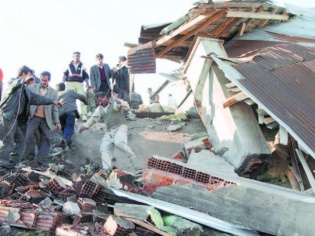-
Aravind
16th Jul 2015
Even in this age of technological advancements, earthquake has been a puzzle. Nobody has been able to predict an earthquake so far, and India along with 26 other countries is planning to develop early earthquake warning system.
In the past decade 11 earthquakes of magnitude of five and above has hit the country and it is no surprise that the country is looking at it seriously.
India’s 22 states, mostly in north India, are prone to earthquakes and fall under severe, high, moderate and low categories. Most of the zones that fall under severe category are situated in the foothills of the Himalayas.
Recently Nepal, India and Bangladesh were affected by the earthquake in Nepal, where more than 10,000 lives were lost.
"Scientists, geophysicists and seismologists of 27 countries are working under India's leadership on an ambitious project to develop early warning system for earthquakes to predict them a few seconds before they occur," said Shailesh Nayak, secretary of the ministry of earth science.
It is notable that India will be working with countries like Japan that are situated in one of the most active seismic zones on earth to develop the early warning system.
The aim is to get the warning a few seconds early, which might bring down the number of casualties.

What will they do?
India is planning to launch a satellite to visualize surface displacement relating to earthquake in 2019. The satellite will be equipped to send images of surface displacement up to the accuracy of few centimetres.
Some chemical changes under the earth's surface and some physical displacements on the surface occur before earthquakes. The countries are looking to analyse it and hoping that this will help predict earthquakes.
Many deep bore wells, filled with sensors and other equipment, will be put in place in all seismically active regions in the country to sense the chemical and physical changes under the earth's surface in the coming years.
This not the first time that people are trying to solve this puzzle. Even in the past there have been efforts to predict earthquakes, but have never been successful.
Other ways to predict earthquakes
Animal behaviour
The seismological bureau in Nanjing has converted seven ordinary farms into seismic activity detection stations, believing that by closely monitoring the behaviour of barnyard animals, they will be able to successfully forecast earthquakes
This follows a study on the Andes mountains, that witnessed change in animal behaviour before an earthquake of 7.0 magnitude hit Peru in 2011.
Using motion-activated cameras, scientists recorded five or fewer animal sightings a day in the 23-days leading up to the quake, compared with five to 15 sightings beforehand.
For five of the seven days immediately before the quake, no movements were recorded
Disturbances in ionosphere
The scientists also detected disturbances in the ionosphere starting two weeks before the quake. A particularly large fluctuation was recorded eight days beforehand, coinciding with the second significant decrease in pre-quake animal activity.
Positive ions in the air were considered a likely cause of the unusual animal behaviour. Such ions are generated in large numbers at the earth's surface when rocks deep below are subjected to increasing stresses during the build-up to a quake.
The ions can cause an increase in serotonin levels in the bloodstream, leading to symptoms such as restlessness, agitation, hyperactivity and confusion.
Smartphone sensors may play a role
Another study, led by scientists at the U.S. Geological Survey (USGS), found that the sensors in smartphones could be used to build earthquake warning systems. The GPS receivers in a smartphone can detect the permanent ground movement caused by fault motion in a large earthquake and using crowdsourced observations from users’ smartphones, scientists could detect and analyze earthquakes, and send them warnings.
All these are efforts towards gaining those few crucial seconds before the earthquake. While developing this it is also important the system that can alert the residents just before the earthquake.
Considering that some of the Severe intensity areas fall are in the remote parts of Himalayas getting the message across at the right time plays a crucial role. So, India will have to build communication infrastructure in these areas as well.
Earthquake, Earthquake Prediction, Earthquake Warning System
India Joins 26 Countries To Develop Early Earthquake Warning System | TechTree.com
India Joins 26 Countries To Develop Early Earthquake Warning System
Countries have been struggling to find a solution to how to predict earthquakes
News Corner
- DRIFE Begins Operations in Namma Bengaluru
- Sevenaire launches ‘NEPTUNE’ – 24W Portable Speaker with RGB LED Lights
- Inbase launches ‘Urban Q1 Pro’ TWS Earbuds with Smart Touch control in India
- Airtel announces Rs 6000 cashback on purchase of smartphones from leading brands
- 78% of Indians are saving to spend during the festive season and 72% will splurge on gadgets & electronics
- 5 Tips For Buying A TV This Festive Season
- Facebook launches its largest creator education program in India
- 5 educational tech toys for young and aspiring engineers
- Mid-range smartphones emerge as customer favourites this festive season, reveals Amazon survey
- COLORFUL Launches Onebot M24A1 AIO PC for Professionals







TECHTREE